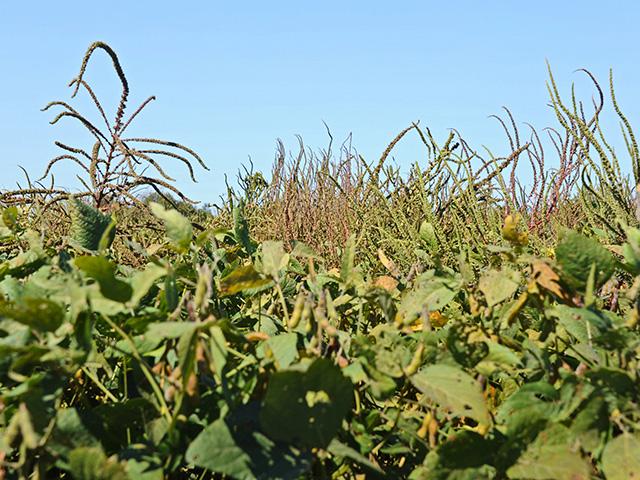Glufosinate-Resistant Pigweed
Glufosinate-Resistant Palmer Amaranth Confirmed in Arkansas
ROCKVILLE, Md. (DTN) -- Scientists in Arkansas have confirmed the presence of glufosinate-resistant Palmer amaranth populations in two northeastern counties of the state.
The populations were collected from two fields in Mississippi County in 2020 and one field in Crittenden County in 2019, said Tom Barber, a University of Arkansas Extension weed scientist. The Crittenden County weeds were found to be 3.5 times more resistant to glufosinate than susceptible weeds, and the Mississippi County weeds appear at least 15 times more resistant than susceptible weeds, Barber explained in a university blog posted Wednesday.
The Arkansas scientists are testing the three pigweed populations for resistance to other modes of action, as well. For now, the glufosinate-resistant weeds do not seem widespread, Barber said.
"Currently, this problem does not appear to be widespread across Mississippi and Crittenden county or the northeast Arkansas area based on extensive screenings that have been taking place in this geography," Barber wrote. "Although it stands to reason that several other fields likely contain small segments of the Palmer amaranth population that has reduced sensitivity to glufosinate."
Palmer amaranth is only the second weed in the U.S. to develop resistance to glufosinate, after glufosinate-resistant Italian ryegrass was documented in Oregon in 2010 and California in 2015.
P[L1] D[0x0] M[300x250] OOP[F] ADUNIT[] T[]
But Palmer amaranth is an especially aggressive and hard-to-control weed, which makes this new finding an ominous one, particularly for cotton and soybean growers, who are fast running out of herbicide options to control it. Palmer amaranth first developed glyphosate resistance in the early 2000s, and glufosinate, sold commonly as Liberty, has been a mainstay of pigweed control in the Southern states since then.
"This finding will represent the first documented case of broadleaf resistance to glufosinate herbicide in the world," Barber noted. "It is not a big surprise that Palmer amaranth has developed resistance to glufosinate considering the history," he added. "Cotton producers have heavily relied on glufosinate since 2007, where widespread occurrence of glyphosate (Roundup) resistance was present in pigweed populations across this geography."
That reliance has deepened in recent years, as glufosinate tolerance has been bred into more cotton and soybean varieties. Currently, most herbicide-tolerant cotton varieties (including LibertyLink, Enlist and XtendFlex) and herbicide-tolerant soybeans platforms on the market (including XtendFlex, Enlist E3, LibertyLink GT27 and LibertyLink soybeans) contain glufosinate tolerance. See more here: https://www.dtnpf.com/….
According to the U.S. Geological Survey, glufosinate use has swelled from roughly 2.5 million pounds per year in 2007 to nearly 15 million pounds per year in 2017. Most of that growth has come in soybean and cotton fields.
Glufosinate is the second herbicide in a year to show cracks against Palmer amaranth. In the summer of 2020, Tennessee weed scientists also confirmed dicamba-resistant Palmer amaranth populations. (See the DTN story here: https://www.dtnpf.com/….)
So far, dicamba still appears to control the glufosinate-resistant populations, Barber noted. But he urged growers to watch for pigweed escapes in their fields this summer and adjust their weed management as necessary.
"Special care should be taken in the future to remove any escaped pigweed populations prior to seed set, regardless of crop grown in the field," he said. "In addition, we are recommending that these fields be rotated to corn if possible due to the herbicide alternatives available in a corn production system."
Growers who decide to stick with cotton or soybeans should consider the Enlist system, since 2,4-D-choline (Enlist One) combined with glufosinate still shows consistent control of Palmer amaranth, Barber added. He also urged growers to apply multiple residual herbicides at planting time, as well as overlapping group 15 residual herbicides after emergence.
"Unfortunately, all of these suggestions are short-term solutions," Barber concluded. "A long-term solution for pigweed control in Arkansas will require multiple cultural tactics, including deep tillage, cover crops, crop rotation, hand weeding and harvest weed seed control to reduce selection pressure from current herbicides and increase focus on pigweed seed bank reduction."
See Barber's blog post here: https://arkansascrops.uaex.edu/….
Emily Unglesbee can be reached at Emily.unglesbee@dtn.com
Follow her on Twitter @Emily_Unglesbee
(c) Copyright 2021 DTN, LLC. All rights reserved.






